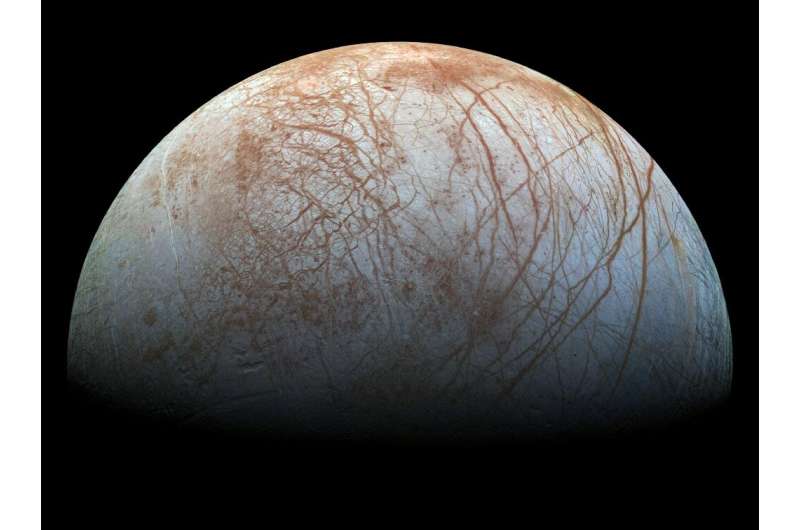NASA’s Europa Clipper mission is set to launch in October 2024, embarking on a 5.5-year journey to Jupiter’s icy moon Europa. Scientists believe Europa may harbor a subsurface ocean, making it a prime candidate for potential extraterrestrial life. The probe will gather data on Europa’s composition, structure, and interaction with its ocean, shedding light on whether the necessary ingredients for life – water, energy, and chemical compounds – are present. This groundbreaking mission could revolutionize the search for life beyond Earth, expanding our understanding of habitable worlds in our solar system and beyond.

Unlocking the Secrets of Europa: NASA’s Europa Clipper Mission
For decades, scientists have been intrigued by the possibility of life on Europa, one of Jupiter’s moons. This icy world is believed to harbor a vast subsurface ocean, making it a prime candidate for extraterrestrial life.
NASA’s Europa Clipper mission, scheduled to launch in October 2024, aims to uncover the secrets of this enigmatic moon. The probe, designed to be the largest ever built for interplanetary exploration, will embark on a 5.5-year journey to Jupiter, where it will conduct a series of 49 close flybys of Europa.
During these flybys, the Europa Clipper will use a suite of sophisticated instruments, including cameras, spectrographs, radar, and magnetometers, to study the moon’s icy surface, its ocean, and the interaction between the two. The mission’s primary goal is to determine whether the three key ingredients for life – water, energy, and certain chemical compounds – are present on Europa.
Exploring Europa’s Potential for Habitability
The Europa Clipper mission is a significant step forward in the search for life beyond Earth. While the probe will not directly look for signs of life, it will gather crucial data that could help determine whether Europa is a potentially habitable world.
Scientists believe that Europa’s subsurface ocean, which is estimated to be up to 100 kilometers deep, could be a prime environment for primitive lifeforms, such as bacteria, to thrive. However, these potential lifeforms would likely be too deep for the Europa Clipper to detect.
Instead, the mission will focus on understanding the structure and composition of Europa’s icy surface, the depth and salinity of its ocean, and the way the two interact. This information will help determine if the necessary ingredients for life – water, energy, and chemical compounds – are present on the moon.
If the Europa Clipper finds evidence that these key ingredients are present, it would pave the way for a future mission to directly search for signs of life on the moon. Such a discovery would have profound implications for our understanding of the potential for life in the universe.
NASA’s Europa Clipper mission is a critical step in the ongoing search for extraterrestrial life. By unlocking the secrets of this enigmatic moon, the probe could revolutionize our understanding of habitable worlds beyond Earth and inspire further exploration of the solar system and beyond.
Expanding the Boundaries of Habitability in the Solar System
The Europa Clipper mission is part of a broader effort to explore the boundaries of habitability in our solar system. While Mars has long been a focus of astrobiological research, Europa represents a new frontier in the search for life beyond Earth.
Unlike Mars, which may have been habitable in the distant past, Europa is believed to be potentially habitable today. The moon’s subsurface ocean, which is shielded from the harsh radiation of space by its icy crust, could provide a stable and protected environment for life to thrive.
If the Europa Clipper mission confirms the presence of the necessary ingredients for life on the moon, it would significantly expand our understanding of where life could potentially exist in the universe. This would have far-reaching implications for the search for extraterrestrial intelligence (SETI) and the ongoing exploration of other potentially habitable worlds within and beyond our solar system.
Moreover, the success of the Europa Clipper mission could inspire further investment in space exploration, leading to the development of even more sophisticated technologies and probes capable of directly searching for signs of life on the moon. This could ultimately pave the way for future crewed missions to Europa, where scientists could conduct more in-depth investigations of the moon’s potential for habitability.
Overall, the Europa Clipper mission represents a critical step in our understanding of the limits of life in the universe. By exploring this intriguing moon, NASA and the scientific community as a whole are poised to make groundbreaking discoveries that could redefine our search for extraterrestrial life and reshape our perspectives on the habitable potential of other worlds.
